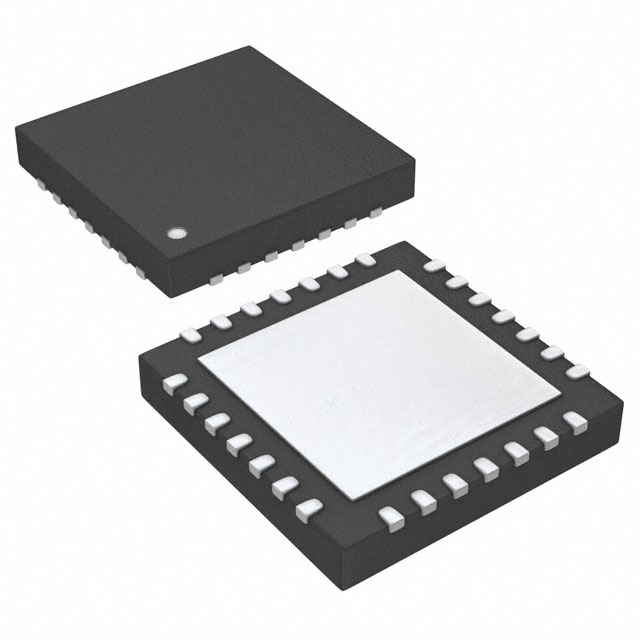PIC16F87T-I/ML
Introduction
The PIC16F87T-I/ML is a microcontroller belonging to the PIC16F family of microcontrollers developed by Microchip Technology. This entry provides an overview of the product, including its category, use, characteristics, package, essence, packaging/quantity, specifications, detailed pin configuration, functional features, advantages and disadvantages, working principles, detailed application field plans, and alternative models.
Basic Information Overview
- Category: Microcontroller
- Use: The PIC16F87T-I/ML is widely used in embedded control applications such as automotive, industrial, appliances, and consumer electronics.
- Characteristics: It features high performance, low power consumption, and a wide range of peripherals for various applications.
- Package: The PIC16F87T-I/ML is available in a 28-pin QFN package.
- Essence: It is designed to provide efficient and reliable control in embedded systems.
- Packaging/Quantity: The PIC16F87T-I/ML is typically supplied in reels with a quantity specified by the manufacturer.
Specifications
- Architecture: 8-bit
- CPU Speed: Up to 20 MHz
- Program Memory Size: 7 KB
- RAM Size: 368 bytes
- I/O Pins: 22
- Timers: 3
- Analog-to-Digital Converters (ADC): 8 channels, 10-bit resolution
- Communication Interfaces: USART, SPI, I2C
- Operating Voltage Range: 2.0V to 5.5V
- Temperature Range: -40°C to +125°C
Detailed Pin Configuration
The PIC16F87T-I/ML has 28 pins, each serving specific functions related to input/output, power supply, communication, and control. A detailed pinout diagram is provided in the datasheet for precise reference.
Functional Features
- Peripheral Integration: The microcontroller integrates various peripherals such as timers, ADC, and communication interfaces, reducing the need for external components.
- Low Power Consumption: It offers low power operation, making it suitable for battery-powered applications.
- Flexible I/O Configuration: The I/O pins can be configured for digital input/output or analog input, providing flexibility in interfacing with external devices.
Advantages and Disadvantages
Advantages
- High performance for embedded control applications
- Wide operating voltage range allows for versatile power supply options
- Integrated peripherals reduce external component count and PCB footprint
Disadvantages
- Limited program memory size compared to newer microcontrollers
- Limited RAM size may restrict complex data processing tasks
Working Principles
The PIC16F87T-I/ML operates based on the Harvard architecture, where program and data memories are separate. It executes instructions fetched from program memory and interacts with peripherals and I/O devices based on the program logic.
Detailed Application Field Plans
The PIC16F87T-I/ML finds applications in various fields, including: - Automotive: Engine control, dashboard displays, and body control modules - Industrial: Process control, monitoring systems, and automation - Appliances: Home automation, smart appliances, and motor control - Consumer Electronics: Remote controls, sensor interfaces, and display drivers
Detailed and Complete Alternative Models
- PIC16F88-I/P: Similar architecture with enhanced memory and peripheral features
- PIC18F25K50-I/SP: Higher performance 8-bit microcontroller with USB interface
- PIC24FJ64GA002-I/SP: 16-bit microcontroller with advanced features for demanding applications
In conclusion, the PIC16F87T-I/ML is a versatile microcontroller suitable for a wide range of embedded control applications. Its integration of peripherals, low power consumption, and flexible I/O make it a popular choice among developers. However, its limited memory and RAM may require careful consideration for more complex applications.
Word Count: 579
قم بإدراج 10 أسئلة وإجابات شائعة تتعلق بتطبيق PIC16F87T-I/ML في الحلول التقنية
Question: What is the maximum clock frequency for PIC16F87T-I/ML?
Answer: The maximum clock frequency for PIC16F87T-I/ML is 20 MHz.Question: Can PIC16F87T-I/ML be used in battery-powered applications?
Answer: Yes, PIC16F87T-I/ML can be used in battery-powered applications due to its low power consumption.Question: What are the available communication interfaces on PIC16F87T-I/ML?
Answer: PIC16F87T-I/ML supports USART, SPI, and I2C communication interfaces.Question: Is PIC16F87T-I/ML suitable for motor control applications?
Answer: Yes, PIC16F87T-I/ML can be used for motor control applications with appropriate interfacing and programming.Question: What are the available memory options for program storage on PIC16F87T-I/ML?
Answer: PIC16F87T-I/ML offers 8 KB of Flash program memory for code storage.Question: Can PIC16F87T-I/ML interface with analog sensors?
Answer: Yes, PIC16F87T-I/ML features analog-to-digital converters (ADC) for interfacing with analog sensors.Question: Does PIC16F87T-I/ML support interrupt handling?
Answer: Yes, PIC16F87T-I/ML provides interrupt handling capabilities for efficient event-driven programming.Question: What development tools are compatible with PIC16F87T-I/ML?
Answer: PIC16F87T-I/ML is supported by popular development tools such as MPLAB X IDE and MPLAB XC compilers.Question: Can PIC16F87T-I/ML operate in harsh industrial environments?
Answer: Yes, PIC16F87T-I/ML is designed to withstand harsh industrial environments with proper precautions.Question: Are there any application notes or reference designs available for PIC16F87T-I/ML?
Answer: Yes, Microchip provides comprehensive application notes and reference designs for utilizing PIC16F87T-I/ML in various technical solutions.


